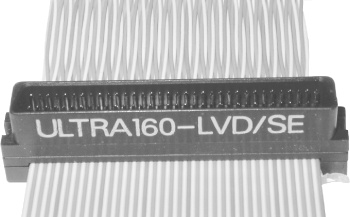Wide single-ended SCSI cables, connectors, and signals
Wide (16-bit) SCSI transfer modes use wide (68-pin) cables. Officially, a wide cable is called a SCSI P cable, but it may also be called a SCSI-2 cable or a 68-pin SCSI cable. A P cable may use any of several connectors, most commonly high-density 68-pin internal, high-density 68-pin external, and VHDCI 68-pin external. Wide SCSI uses 68 signals, each carried on one of the 68 wires in the SCSI P cable, with the 68 wires organized into 34 pairs. For SE SCSI, each pair includes a signal wire and a signal return (ground) wire. Figure 13-6 shows a SCSI P cable with an internal 68-pin high-density connector. Note the twisted pairs in the cable segment at top.

Figure 13-6. SCSI P cable with 68-pin high-density connector
Tip
Early wide SCSI implementations used an awkward combination of two cables: a standard 50-pin A cable and a special 68-pin B cable. The B cable was never popular, and the combination A+B cabling was quickly replaced by the single 68-pin P cable.
Table 13-11 lists the pinouts for SCSI P cables and connectors. A “#” following a signal name indicates that signal is active-low. In a P cable, (reserved) lines are left open in SCSI devices and terminators. Although conductor numbers do not map directly to pin numbers, all P cable connectors use the same pinouts.
Tip
A 32-bit SCSI Q cable was defined, but that cable was never ...
Get PC Hardware in a Nutshell, 3rd Edition now with the O’Reilly learning platform.
O’Reilly members experience books, live events, courses curated by job role, and more from O’Reilly and nearly 200 top publishers.

